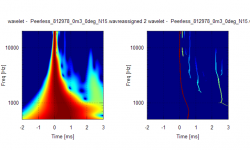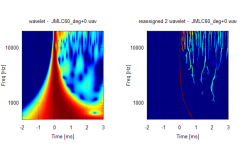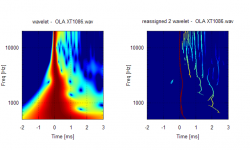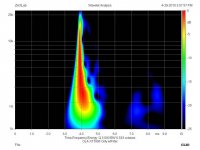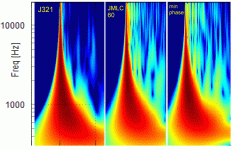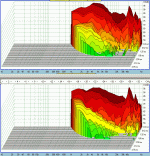I'm yet to see a horn OR a waveguide + driver combination without this pre 2ms garbage!! DOES ONE EXIST??
Do you have any direct radiator measurements that are clean?? Are you sure it's unique to horns and waveguides??
Rob🙂
I suspect it has to do with measurement method. This is also somthing I am trying to find out. If you can see if waveletts can be generated on the data files here,Hi,
Here's some analysis of the 18sound XT1086 in ZilchLab's product.
Wavelet is calculated at 200Hz-20kHz showing the nice measurement environment with all those reflections 😀
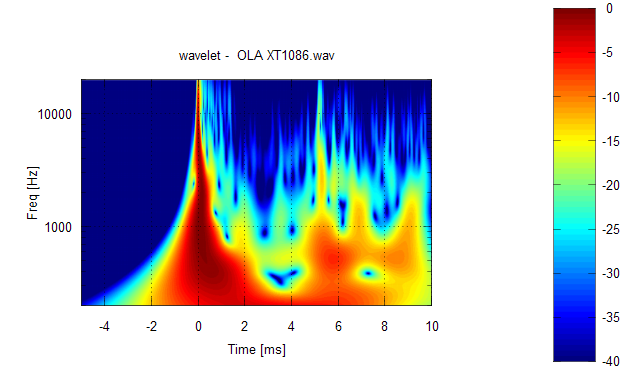
The reassigned wavelet points the 1-2ms reflections/diffractions that seem to be so typical to the horns/waveguides in this thread 🙂 I'm yet to see a horn OR a waveguide + driver combination without this pre 2ms garbage!! DOES ONE EXIST?? 😕
From the reassignment one can have the most natural group delay by looking the dark red curve. This is the delay that the energy undergoes when travelling through the system.
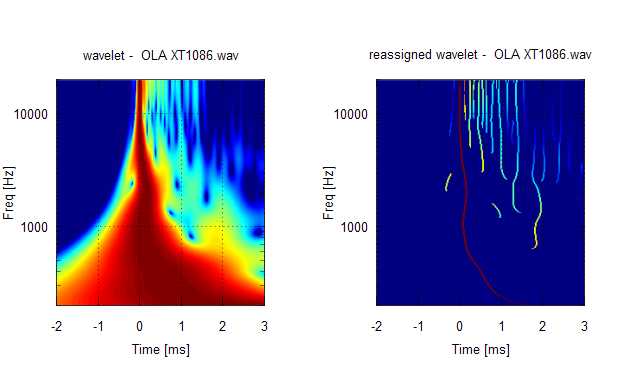
- Elias
http://www.diyaudio.com/forums/multi-way/161627-horn-honk-wanted-65.html#post2155678
I have actual measurements we can jointly explore.
Hello,
In order to get some reference, here's 20€ Peerless dome tweeter in a test baffle 😀 The tweeter is non-flush mounted so there is some front plate diffraction visible at 0.2ms above 10kHz. Also there is two baffle diffractions, 0.5ms and 1ms, one for short side and other for the long side of the test baffle. Reflections after 2ms is from the chair the test baffle was placed on. However, the driver is clean 😀
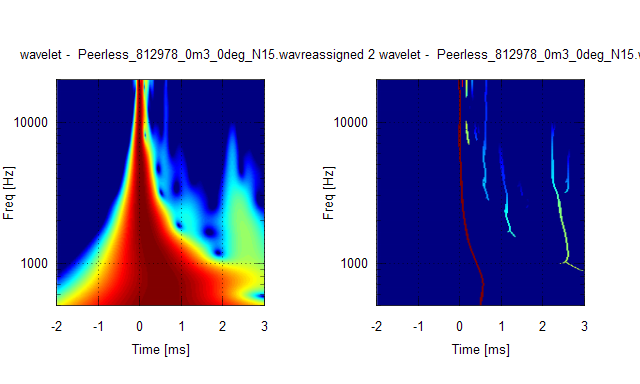
Comparison is made to jzagaja's JMLC horn
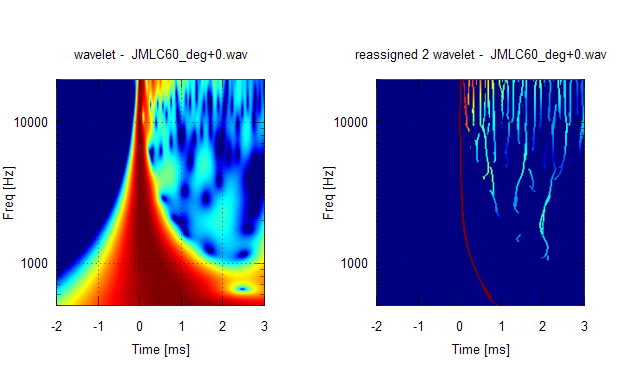
and ZilchLab OLA horn.
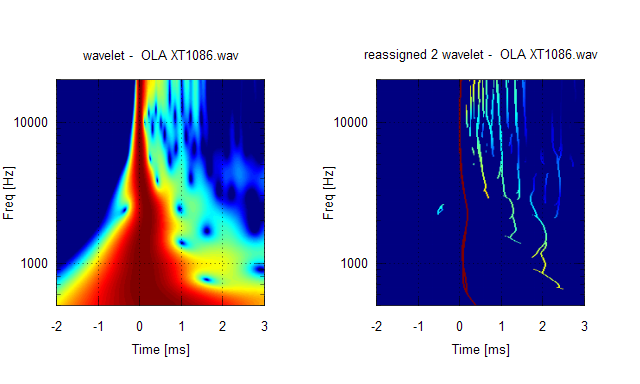
As can be seen the problems arrive from the acoustic surrounding elements of the driver. Cabinets, horns and waveguides belong to this troublesome acoustics surroundings 🙂
- Elias
In order to get some reference, here's 20€ Peerless dome tweeter in a test baffle 😀 The tweeter is non-flush mounted so there is some front plate diffraction visible at 0.2ms above 10kHz. Also there is two baffle diffractions, 0.5ms and 1ms, one for short side and other for the long side of the test baffle. Reflections after 2ms is from the chair the test baffle was placed on. However, the driver is clean 😀

Comparison is made to jzagaja's JMLC horn

and ZilchLab OLA horn.

As can be seen the problems arrive from the acoustic surrounding elements of the driver. Cabinets, horns and waveguides belong to this troublesome acoustics surroundings 🙂
- Elias
Do you have any direct radiator measurements that are clean?? Are you sure it's unique to horns and waveguides??
Rob🙂
Attachments
Last edited:
More OLA XT1086 data; still in the same cab, horn only and horn plus highpass filter:


Attachments
Last edited:
Direct radiating drivers are always going to be cleaner than horns without foam inserts. This is can be concluded from basic understanding of physics. However, when one looks at data, and see something out of the regular, it takes more understanding to determine what is caused by what.😉
No, its not the question of „foam or not foam“ !
Foam - or any other dampening material - has only limited effect on reducing odd impact of looped reflections.
Also - its effect in dampening quarter wave honk is frequency dependent.
Also - *any* dampening material adds its own sonic pattern - which (at least to my personal taste and experience) is always a further degradation in sonics.
If we go back to "physics" understanding -
- the veeeery early reflections we see here in most horn plots are not from the "horn" but from the compression driver itself (diffraction at phase plug parts etc.) - being integral part of the horn contour of course, as noted several times - plus the reflections at point of compression driver / horn joint .
Better or worse quality and integration to the horn are easily seen by comparison:
http://www.diyaudio.com/forums/multi-way/161627-horn-honk-wanted-6.html#post2123150
So I'd say we have a pretty sharp and useful tool in wavlet analysis to intuitively determine sonics in a quantitavie manner – something not being avalable until now for those specific quarter wave horn honk effects and the effects of "resolution smear" in the very first time span of impulses
🙂
BTW
To do fair comparison we have to look at the scaling - its pretty worthless to compare a 25dB and a 40dB plot - also its necessary to show normalized plots for a comparison that holds...
😉
Michael
Foam - or any other dampening material - has only limited effect on reducing odd impact of looped reflections.
Also - its effect in dampening quarter wave honk is frequency dependent.
Also - *any* dampening material adds its own sonic pattern - which (at least to my personal taste and experience) is always a further degradation in sonics.
If we go back to "physics" understanding -
- the veeeery early reflections we see here in most horn plots are not from the "horn" but from the compression driver itself (diffraction at phase plug parts etc.) - being integral part of the horn contour of course, as noted several times - plus the reflections at point of compression driver / horn joint .
Better or worse quality and integration to the horn are easily seen by comparison:
http://www.diyaudio.com/forums/multi-way/161627-horn-honk-wanted-6.html#post2123150
So I'd say we have a pretty sharp and useful tool in wavlet analysis to intuitively determine sonics in a quantitavie manner – something not being avalable until now for those specific quarter wave horn honk effects and the effects of "resolution smear" in the very first time span of impulses
🙂
BTW
To do fair comparison we have to look at the scaling - its pretty worthless to compare a 25dB and a 40dB plot - also its necessary to show normalized plots for a comparison that holds...
😉
Michael
Last edited:
I think someone might be interested in verifying the effects of foam. Since I don't plan to use it. I think anyone that has done some simulations in AxiDriver can find out how the compression driver impact is. I ran some quick sims, both they are buried in vast amounts of data files, but who's web site was that that posted tests on tube terminated with a small horn? That's what's going on with compression driver with an OSWG.
The wavelet transformations are certainly useful in comparisons, but is not a necessary tool for development work. Seems like nobody was interested in looking at other data I posted. So I guess I won't talk about it either. Measurement setup is going to effect measurement results.
The wavelet transformations are certainly useful in comparisons, but is not a necessary tool for development work. Seems like nobody was interested in looking at other data I posted. So I guess I won't talk about it either. Measurement setup is going to effect measurement results.
I've posted some CSD data of a full range driver in the EnABL thread. 😀I think this tweeter does not peform so good.Hello,
In order to get some reference, here's 20€ Peerless dome tweeter in a test baffle 😀 The tweeter is non-flush mounted so there is some front plate diffraction visible at 0.2ms above 10kHz. Also there is two baffle diffractions, 0.5ms and 1ms, one for short side and other for the long side of the test baffle. Reflections after 2ms is from the chair the test baffle was placed on. However, the driver is clean 😀

...
- Elias
Elias,
It is very unfair to have taken for such comparison a measurement at 60 degrees from the axis of a Le Cléac'h horn.
At high frequency (above 8kHz) there is nearly no energy emitted at 60 degrees with that horn so the normalization amplifies very very weak signals.
Best regards from Paris, France
Jean-Michel Le Cléac'h
It is very unfair to have taken for such comparison a measurement at 60 degrees from the axis of a Le Cléac'h horn.
At high frequency (above 8kHz) there is nearly no energy emitted at 60 degrees with that horn so the normalization amplifies very very weak signals.
Best regards from Paris, France
Jean-Michel Le Cléac'h
Comparison is made to jzagaja's JMLC horn

Last edited:
Jean-Michel,
No, the impulse response is on axis 0 deg. The horn name is "JMLC-60 (350Hz)".
See here post #554 where can be found impulse responses in 10 degree angles.
- Elias
http://www.diyaudio.com/forums/multi-way/161627-horn-honk-wanted.html#post2145714
No, the impulse response is on axis 0 deg. The horn name is "JMLC-60 (350Hz)".
See here post #554 where can be found impulse responses in 10 degree angles.
- Elias
http://www.diyaudio.com/forums/multi-way/161627-horn-honk-wanted.html#post2145714
Elias,
It is very unfair to have taken for such comparison a measurement at 60 degrees from the axis of a Le Cléac'h horn.
At high frequency (above 8kHz) there is nearly no energy emitted at 60 degrees with that horn so the normalization amplifies very very weak signals.
Best regards from Paris, France
Jean-Michel Le Cléac'h
Hello Elias,
OK, I see now...
If we compare the wavelets graphs for the JMLC-60 (350Hz) and the Min-Phase horn (500Hz):
Jmmlc60 and minphase
http://www.diyaudio.com/forums/multi-way/161627-horn-honk-wanted-61.html#post2154302
we can see that the short delays reflexions, diffractions, homs for those 2 graphs are very similar despite their very different profiles. We can admit that there is a strong signature of the driver used by Jzagaja for both measurements, the 2" STX-D1300-Ti
On the frequency responses curves given by Jzagaja every 5 degrees,
http://www.diyaudio.com/forums/atta...rman-diy-show-gelsenkirchen-jmlc_minphase.gif
we can see that the 2" STX-D1300-Ti driver is a bit problematic over 8kHz.
Then when we compare (see attached file) the wavelets graphs for my J321 (320Hz) horn loading the TAD TD2001 1" compression driver with the JMLC60 and the Min-Phase:
We can see that the J321 loading the TD2001 has a cleaner wavelet graph (that Jerzual horn built my friend Marco Hernry was specially designed to be used with the TAD TD2001).
You should have used for your demonstartion a more illustrating comparison as on the graph:
http://www.diyaudio.com/forums/attachments/multi-way/165825d1270549429-horn-honk-wanted-3horns_.gif
Best regards from Paris, France
OK, I see now...
If we compare the wavelets graphs for the JMLC-60 (350Hz) and the Min-Phase horn (500Hz):
Jmmlc60 and minphase
http://www.diyaudio.com/forums/multi-way/161627-horn-honk-wanted-61.html#post2154302
we can see that the short delays reflexions, diffractions, homs for those 2 graphs are very similar despite their very different profiles. We can admit that there is a strong signature of the driver used by Jzagaja for both measurements, the 2" STX-D1300-Ti
On the frequency responses curves given by Jzagaja every 5 degrees,
http://www.diyaudio.com/forums/atta...rman-diy-show-gelsenkirchen-jmlc_minphase.gif
we can see that the 2" STX-D1300-Ti driver is a bit problematic over 8kHz.
Then when we compare (see attached file) the wavelets graphs for my J321 (320Hz) horn loading the TAD TD2001 1" compression driver with the JMLC60 and the Min-Phase:
We can see that the J321 loading the TD2001 has a cleaner wavelet graph (that Jerzual horn built my friend Marco Hernry was specially designed to be used with the TAD TD2001).
You should have used for your demonstartion a more illustrating comparison as on the graph:
http://www.diyaudio.com/forums/attachments/multi-way/165825d1270549429-horn-honk-wanted-3horns_.gif
Best regards from Paris, France
No, the impulse response is on axis 0 deg. The horn name is "JMLC-60 (350Hz)".
http://www.diyaudio.com/forums/multi-way/161627-horn-honk-wanted.html#post2145714
Attachments
Hi,
Yes TAD TD2001 is good but it comes with the price of 1450$.
Is it fair to compare it with 20€ dome tweeter 😀
Of course these are very different concepts in every way.
However, the point is that horns and waveguides + drivers are very hard to get right and only in the very top end of the gategory (1000++€) they start to approach the cleaniness of a simple dome tweeter.
- Elias
Yes TAD TD2001 is good but it comes with the price of 1450$.
Is it fair to compare it with 20€ dome tweeter 😀
Of course these are very different concepts in every way.
However, the point is that horns and waveguides + drivers are very hard to get right and only in the very top end of the gategory (1000++€) they start to approach the cleaniness of a simple dome tweeter.
- Elias
We can see that the J321 loading the TD2001 has a cleaner wavelet graph (that Jerzual horn built my friend Marco Hernry was specially designed to be used with the TAD TD2001).
Very few horns I've heard offers good compromise between honk and dynamics. If we get rid of more honk and maintain the dynamics, then we have a good balance.
Hello Soongsc,
Better to listen inside the waveguide 🙂)))
Best regards from Paris, France
Jean-Michel Le Cléac'h
Better to listen inside the waveguide 🙂)))
Best regards from Paris, France
Jean-Michel Le Cléac'h
CSD outside a WG/Horn vs inside a WG/Horn
Hi,
Yes TAD TD2001 is good but it comes with the price of 1450$.
Is it fair to compare it with 20€ dome tweeter 😀
Of course these are very different concepts in every way.
However, the point is that horns and waveguides + drivers are very hard to get right and only in the very top end of the gategory (1000++€) they start to approach the cleaniness of a simple dome tweeter.
- Elias
With „wavelet transform“ we certainly got aware of an audio analysis tool that brings a lot of things to our attention, that were not so obvious yet.
It also teaches us – in a more clear way then ever - that for horns *the contour starts at the diaphragm* - which is a point of view not widly spread in the horn community, i guess.
So I'm really greatful that all this came up and got pinned down in an objective manner.
Also – I think – this tool will have a lot of influence in DIY horn design as it makes development / improvement of that specifc issue more transparent.
Regarding price to be paied for a „low honk / low smear horn“, below competition plots might be an eye opener.
Though its vastly accepted, its not exactly true that compression driver are *the best and only* performers on horn contours.
Once more - the same NEO3 tweeter - at horn contour and in open baffle configuration :
Open baffle :

120deg (included) honker :

Look at the NORMALISED plot to get the interesting difference,
The main refection at OB is around 1ms according to (rectangular) baffle size – in the frst 1ms the response is basically clean (well - almost ) !
With the 120deg conical honker things are different.
As there is sharp 60deg diffraction at the driver / horn joint, we have created „second sources“ right at the circumference of the NEO3 - and those got reflected at the conical contour - summing up into the bunch of reflections at the first 1ms we see here.
Bottom line, what we see is horn and OB diffraction effects - but the NEO3 driver itself is basically clean.
🙂
Michael
Last edited:
If anyone was aware, I addressed that issue probably about a year ago in the Geddes thread.😉...... that for horns *the contour starts at the diaphragm* - which is a point of view not widly spread in the horn community, i guess.
...
Michael
worst case
Of course you have been following both threads so you know that the jzagaja measurements were by far the worst of all that were submitted. His inexpensive driver is attached via a sawn off threaded adapter. Jmmlc's measurements look much better but the TAD drivers are way too expensive. I am hoping that the Radian 475 drivers I just bought for a fair price will also be excellent. My 8 petal, paper LeCleac'h horns are drying the final coat of paint so I can get an idea of the performance in a couple weeks. This set up with production quality, fiberglass horns will still be several times the cost of a pair of good tweeters but I am intrigued by testimonials of a good horn's attributes such as effortless micro dynamics, better controlled directivity and ultra low crossover points on a big horn. Projects such as the Raptors
HTGuide Forum - View Single Post - The Raptor ... a 10" MTM
which measure with vanishingly low distortion compared to the best domes, also point to the possible advantages of a good horn.
Of course you have been following both threads so you know that the jzagaja measurements were by far the worst of all that were submitted. His inexpensive driver is attached via a sawn off threaded adapter. Jmmlc's measurements look much better but the TAD drivers are way too expensive. I am hoping that the Radian 475 drivers I just bought for a fair price will also be excellent. My 8 petal, paper LeCleac'h horns are drying the final coat of paint so I can get an idea of the performance in a couple weeks. This set up with production quality, fiberglass horns will still be several times the cost of a pair of good tweeters but I am intrigued by testimonials of a good horn's attributes such as effortless micro dynamics, better controlled directivity and ultra low crossover points on a big horn. Projects such as the Raptors
HTGuide Forum - View Single Post - The Raptor ... a 10" MTM
which measure with vanishingly low distortion compared to the best domes, also point to the possible advantages of a good horn.
Hello,
In order to get some reference, here's 20€ Peerless dome tweeter in a test baffle 😀 The tweeter is non-flush mounted so there is some front plate diffraction visible at 0.2ms above 10kHz. Also there is two baffle diffractions, 0.5ms and 1ms, one for short side and other for the long side of the test baffle. Reflections after 2ms is from the chair the test baffle was placed on. However, the driver is clean 😀

Comparison is made to jzagaja's JMLC horn

and ZilchLab OLA horn.

As can be seen the problems arrive from the acoustic surrounding elements of the driver. Cabinets, horns and waveguides belong to this troublesome acoustics surroundings 🙂
- Elias
- Status
- Not open for further replies.
- Home
- Loudspeakers
- Multi-Way
- Horn Honk $$ WANTED $$
